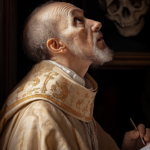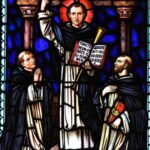St. Teresa of Avila
St. Teresa of Avila
When they lived:
St. Teresa of Avila, also known as St. Teresa of Jesus, lived during the 16th century. She was born on March 28, 1515, and she passed away on October 4, 1582.
Where they lived:
St. Teresa of Avila lived primarily in Spain. She was born in Gotarrendura, a small village in the province of Ávila, and spent much of her life in the region of Castile, Spain. She is closely associated with the town of Ávila itself, where she founded several convents and monasteries.
Notable world events during the time of their life:
- Protestant Reformation (16th century): St. Teresa of Avila lived during a time of religious upheaval in Europe. The Protestant Reformation, initiated by figures like Martin Luther and John Calvin, was challenging the authority of the Catholic Church and leading to significant religious and political changes.
- Exploration and the Age of Discovery: The 16th century was an era of exploration and discovery. This period saw the voyages of explorers such as Christopher Columbus, Ferdinand Magellan, and Hernán Cortés, who opened up new trade routes and expanded European influence around the world.
- Scientific Revolution: The Scientific Revolution was beginning to take shape during St. Teresa’s lifetime. Figures like Nicolaus Copernicus and Galileo Galilei were challenging traditional views of the cosmos, leading to a fundamental shift in our understanding of the universe.
- Spanish Inquisition: St. Teresa of Avila lived during a time when the Spanish Inquisition was active. This institution aimed to maintain Catholic orthodoxy and suppress heresy, leading to significant social and religious tensions in Spain.
- Elizabethan Era in England: In England, during St. Teresa’s lifetime, Queen Elizabeth I was reigning. Her rule was marked by a significant cultural flowering, including the works of William Shakespeare and the expansion of the British Empire.
- Battle of Lepanto (1571): One of the significant military events during her lifetime was the Battle of Lepanto, a naval battle between the Holy League, led by the Papal States and Spain, and the Ottoman Empire. It was a pivotal moment in the ongoing conflict between Christian and Islamic powers in the Mediterranean.
Their patronage:
St. Teresa of Avila is the patron saint of many groups and causes, making her a figure of diverse influence:
- Patroness of Spain: St. Teresa is considered one of Spain’s greatest saints and a symbol of Spanish spirituality.
- Patroness of Catholic Writers: She is the patron saint of writers and theologians, thanks to her own extensive writings on spirituality and mysticism.
- Patroness of Headache Sufferers: Interestingly, she is also invoked by those suffering from headaches, as it is believed that she herself experienced severe migraines.
- Patroness of the Sick: Due to her own health struggles, St. Teresa is often sought after by those who are ill or facing physical ailments.
- Patroness of Lace Workers: This unique patronage is attributed to a story where she lost a book, and a vision of an angel presented it to her with a beautiful piece of lace.
St. Teresa’s life was marked by spiritual fervor, mysticism, and a profound dedication to reforming the Carmelite order. Her writings, including “The Interior Castle” and “The Way of Perfection,” continue to be studied and revered today for their insights into Christian spirituality and mysticism.
Inspired by the martyrs
Teresa de Cepeda y Ahumada was born in Avila, Spain, on March 28, 1515. In her autobiography, she mentions some details of her childhood. Her parents were pious Catholics, which to some degree inspired Teresa to take up a life of prayer. She had three sisters and nine brothers.
As a young child, Teresa showed signs of a deeply religious nature. She would often retreat into silence and spend time praying. She enjoyed giving alms to the poor. However, when she was a teenager, Teresa’s mother, who was very close to her, died, leaving her distraught at the void she left. The young Teresa tells of her despair and how she turned to the Virgin Mary, seeking comfort.
When she was still a child, Teresa often read about the lives of martyrs. This inspired her to long for martyrdom. A few years later, she would speak of her childhood reading and state that she had discovered in it the way of truth, which she summed up in two important principles: “all things of this world will pass away” and that God alone is “for ever, ever, ever”. She was taught by the Augustinian nuns of Santa Maria de las Gracias de Avila. With their instruction and her reading of spiritual books, especially the classics of Franciscan spirituality, Teresa was introduced to recollection and prayer.
Reforming the Carmelite Order
When she was twenty years old, Teresa entered the Carmelite Monastery of the Incarnation in Avila. As a Carmelite, she took the name Teresa of Jesus. Three years later, she fell seriously ill. She was so ill that she remained comatose for four days, looking as if she were already dead. In 1543, she lost the closeness of her relatives. Her father died, and all her siblings, one after another, left for America. During Lent of 1554, when she was 39 years old, Teresa reached the apex of her struggle against her own weakness. Her fortuitous discovery of the statue of Christ most grievously wounded left a deep mark on her life.
At the age of 43, Teresa decided she wanted to found a new order, recommitting to the values of poverty and simplicity. She began to realize her ideal of the reform of the Carmelite Order. In 1562, she founded the first reformed Carmel in Avila with the approval and support of Don Alvaro de Mendoza, the city’s bishop. Shortly afterwards, Teresa’s reforms also received approval from the Superior General of the Order, John Baptist Rosi.
In the succeeding years, Teresa continued her work of founding new Carmelite convents. Under her guidance, seventeen new convents were established. Her encounter with John of the Cross was fundamental. In 1568, Teresa and John of the Cross set up the first convent of Discalced Carmelites in Duruelo, near Avila. In 1580, she obtained authorization from Rome for her reformed Carmels to be a separate and autonomous province. This was the beginning of the Discalced Carmelite Order.
Teresa’s earthly life came to an end while she was in the middle of her founding activities. She died on the night of October 15, 1582, in Alba de Tormes, after setting up the Carmelite Convent in Burgos while on her way back to Avila. Her last humble words were: “After all, I die as a child of the Church”, and “O my Lord and my spouse, the hour that I have longed for has come. It is time to meet one another”. She was beatified by Pope Paul V in 1614 and canonized by Gregory XV in 1622. Her feast day is October 15.
Five Interesting Facts About St. Teresa of Avila
- St. Teresa of Avila wrote her autobiography, Way of Perfection, and Interior Castle. Her works contain some of the most profound insights into the spiritual life ever written.
- Pope Paul VI proclaimed St. Teresa of Avila a Doctor of the Church in 1970. She was one of the four women Doctors of the Church (St. Therese of Lisieux, St. Catherine of Siena, and St. Hildegard of Bingen).
- St. Teresa of Avila is the patron saint of headaches. On many occasions in her writings, she expressed the terrible migraines she experienced.
- St. Teresa of Avila is also the patroness of Spain and the patron saint of lacemakers.
- One of St. Teresa of Avila’s known miracles was the healing of her injured nephew. She performed a miracle after part of a building fell on the boy.
Prayer to St. Teresa of Avila
O God, who through your Spirit raised up Saint Teresa of Jesus to show the Church the way to seek perfection, grant that we may always be nourished by the food of her heavenly teaching and fired with longing for true holiness. Through our Lord Jesus Christ, your Son, who lives and reigns with you in the unity of the Holy Spirit, one God, for ever and ever Amen.



